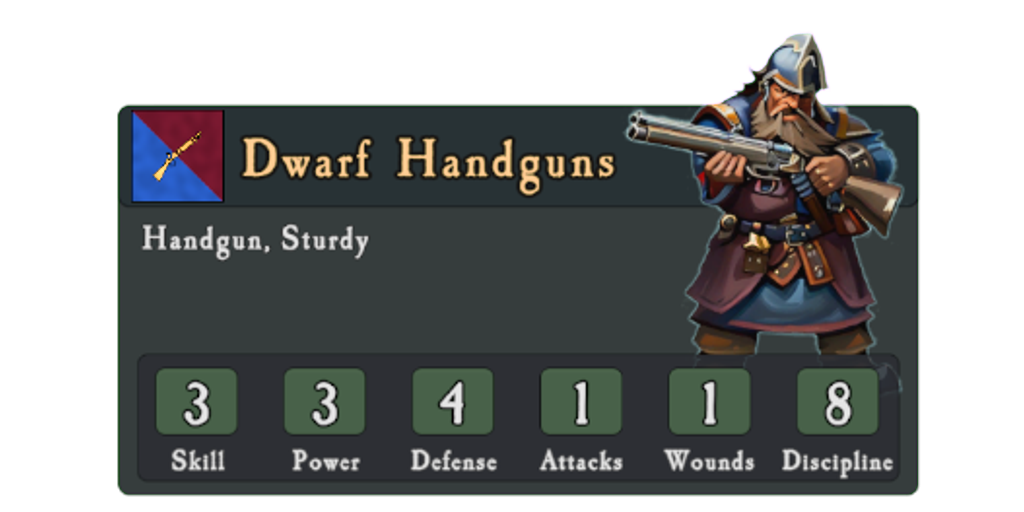
Armies consist of units of soldiers with varying stats and abilities. A units fighting capabilities are described by it’s Stat Block, Equipment and Properties.
The Stat Block
Each unit has a list of stats that describe how good it is at various things.
| Skill | A units Skill is a measure of the units training and general fighting ability. It is used to determine Hit Chance in combat and also for Ranged Attacks. |
| Power | Power describes a units physical strength and hitting power. It’s used in combat to overcome the defenders Defense stat. |
| Defense | Defense is a combination of the units general toughness and armor. It’s used to determine the units Damage Save against incoming hits. |
| Attacks | A units Attacks stat is used to determine how many attacks each model gets to make in combat. |
| Wounds | The Wounds stat tells us how many points of damage each model in a unit can take before it is removed. |
| Discipline | Discipline is a measure of the units bravery and tendency to stick around when things look grim. It’s used for Discipline tests after combat and heavy casualties. |
Discipline and Rank Bonus
In some cases a unit might be required to make a Discipline Test. For example, after a unit loses a combat, or when rallying a fleeing unit.
A discpline test is made by rolling 2d6. If the result is lower than or equal to the units Discipline stat, it is succesful.
When rolling a discipline test units can add their Rank Bonus to their Discipline stat. Each rank with at least 3 models gives +1 Rank Bonus, including the first rank.
Flight Move
In some situations a unit might lose it’s nerve and try to flee from the battlefield. A Flight Move is chaotic, instead of moving normally roll one d6 for each 4 points of base movement allowance. Move the unit that distance in a straight line, avoiding other units and terrain.
If a Flight Move reaches a table edge the unit flees the battlefield. It is considered destroyed for scoring purposes.
Unit Types
Units come in different types which determines some basic properties.
| Unit Type | Base Size | Movement Allowance | Pivot Cost | Description |
|---|---|---|---|---|
| Infantry | 20x20 | 8 | 1 | Basic infantry with a standard base size |
| Infantry | 25x25 | 8 | 1 | Basic infantry with a bigger base size |
| Cavalry | 25x50 | 16 | 2 | Cavalry like Imperial Knights or Wolf Riders |
| Monstrous Infantry | 40x40 | 12 | 1.5 | Bigger infantry units like Trolls or Minotaurs |
| Large Monster | 50x50 | 12 | 1.5 | Huge monsters like Giants |
| Chariot | 50x100 | 16 | 2 | Wheeled chariots |
| War Machine | 50x50 | 0 | 0 | Warmachines like cannons or catapults |
| Weapon Team | 25x50 | 8 | 1 | Weapon Teams like Ratkin Longrifles |
| War Wagon | 50x100 | 12 | 1.5 | War Wagons are similar to chariots, but slower and bulkier. |
| Swarm | 40x40 | 8 | 1 | Swarms of critters like snakes or rats. |
Commanders
Commanders are always the same model type as their retinue or mount. Some commanders are monstrous entities on their own and act as Large Monsters on the battlefield!